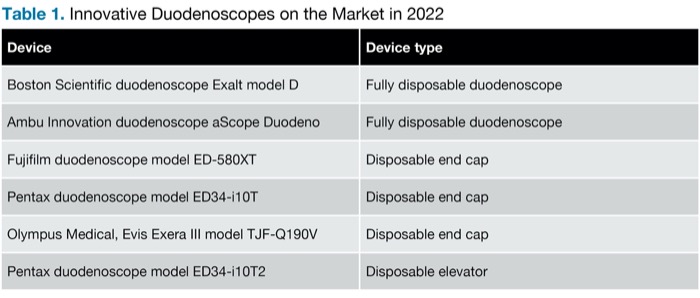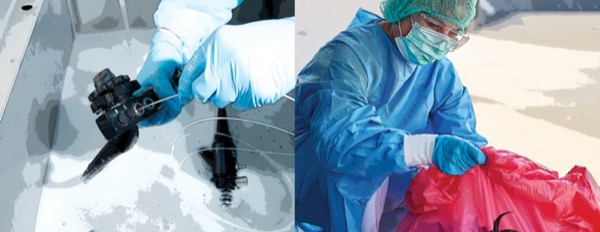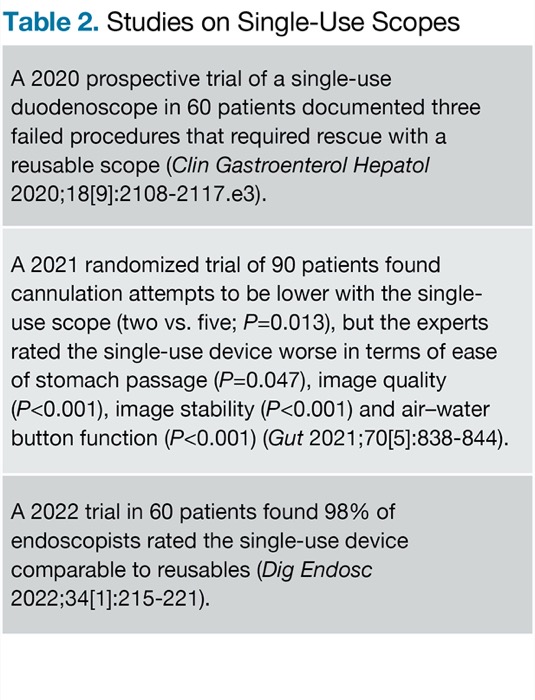By Caroline Helwick
Originally published by our sister publication Gastroenterology & Endoscopy News
San Diego—The potential for infection with reusable duodenoscopes has created an industry for disposable scopes, but some still question whether this is the best approach to the problem. Two expert endoscopists tackled this issue in a debate format at the 2022 Digestive Disease Week.
Tasked with arguing for keeping scopes and doing a better job at reprocessing them was Grace H. Elta, MD, a professor emerita of internal medicine at the University of Michigan, in Ann Arbor. Assigned to push for more single-scope usage was Klaus Mergener, MD, PhD, an affiliate professor of medicine at the University of Washington, in Seattle. Both are past presidents of the American Society for Gastrointestinal Endoscopy.
The speakers discussed the risk for infection with reprocessed scopes, quality of disposable scopes and the environmental impact of both types. Although they disagreed about the issue of widespread adoption of single-use scopes, they agreed that disposable scopes signify long-overdue innovation.
“We have had some, but not much, improvements in scopes over the last three decades, but because of the movement towards disposable scopes, there has been a turbo boost to innovation in recent years,” Dr. Mergener noted (Table 1). “If nothing else, I would encourage us to support disposables because it’s driving innovation in our field.”
| Table 1. Innovative Duodenoscopes on the Market in 2022 | |
| Device | Device type |
|---|---|
| Boston Scientific duodenoscope Exalt model D | Fully disposable duodenoscope |
| Ambu Innovation duodenoscope aScope Duodeno | Fully disposable duodenoscope |
| Fujifilm duodenoscope model ED-580XT | Disposable end cap |
| Pentax duodenoscope model ED34-i10T | Disposable end cap |
| Olympus Medical, Evis Exera III model TJF-Q190V | Disposable end cap |
| Pentax duodenoscope model ED34-i10T2 | Disposable elevator |
More of a ‘Push’ Than a ‘Pull’
As Dr. Elta pointed out, infection associated with endoscopic retrograde cholangiopancreatography (ERCP) is not new, having first been reported in 1987. The issue gained attention in 2015 after about 100 ERCP-associated infections were reported—probably “the tip of the iceberg,” but still “not a huge number,” she observed.
It was enough for the FDA to issue advice for better reprocessing (not all of which panned out), Dr. Elta noted. This was followed in 2018 by the FDA’s recommendation for four additional cleaning and culturing measures (some now outdated). In 2019, the FDA advocated transitioning to scopes with innovative designs to enhance safety.
“Companies then made large investments in researching and developing single-use scopes,” Dr. Mergener said. For these manufacturers, he said, a return on investment won’t be realized by merely “selling a handful of duodenoscopes.” Therefore, the field is seeing “continued push into this area,” he said. “Don’t think that won’t make a difference in terms of where this all ends up. The debate about disposable scopes is driven by a market push more so than by a physician pull,” he maintained.
Infection Risk: Scope of the Problem, Lessons Learned
Concerns have not been unfounded. Early post-marketing data for duodenoscopes showed the incidence of “high-concern” organisms to be 5.4%, although that figure is now lower after better reprocessing. With effort, this rate might be reduced to the 2% range or even lower, Dr. Mergener estimated.
More than 130 individual steps are required during reprocessing, and this complex pathway is prone to errors. Proposed solutions include double-cycle high-level disinfection, further automation, sterilizable endoscopes and disposable end caps.
Although duodenoscopes have been the focus of attention, other types of scopes have channels and nidus areas of potential contamination. “Reported infections are almost certainly an underestimate, ... and surely there’s a risk with other scopes as well,” Dr. Mergener said.
Endoscopists should not be smug about this, as simply not witnessing infectious transmission within one’s own endoscopy suite is not particularly meaningful, he emphasized. “For example, even though you probably haven’t seen one, there are about 40,000 fatal car accidents per year in this country. The infection rate for non-duodenoscopes clearly cannot be zero.”
Dr. Elta agreed and suggested that the major factors leading to contamination are probably poor training, low pay and “insufficient importance placed on the human error factor.” Clearly, it is difficult to clean air and water channels, tears of inner channels, and biofilm, she acknowledged. And unique to duodenoscopes is the complex elevator mechanism and the fact that devices enter sterile spaces through duodenoscopes.
What Level of Risk Is Acceptable?
Knowing that some risk may always exist when scopes are reused, the question then is, “What is an acceptable residual risk, and how does the field get there?” Dr. Mergener asked.
“Do we really need no risk?” Dr. Elta questioned. Culture positivity of duodenoscopes, after implementation of FDA recommendations, was about 5% in a 2022 meta-analysis but only 0.8% for high-risk organisms (Clin Endosc 2022;55[1]:33-40), and the infection rate would be much lower than the culture rate, she noted. “With more attention to reprocessing, we can get to near zero. I think near zero is good enough,” she said.
“If we accept only zero, then we will need disposable esophagogastroduodenoscopes, echoendoscopes and colonoscopes, and that’s over 18 million endoscopes per year in the U.S. alone,” she noted.
The cost of “no risk,” in fact, is exorbitant, she added. In a 2021 cost-effectiveness analysis, high-level disinfection cost $962 compared with the use of the Exalt (Boston Scientific) disposable scope at $3,000. The number needed to treat to prevent one death was 556 (Tech Innov Gastrointest Endosc 2022;24[1]:16-25). Because pass-through payment codes for Exalt procedures have been approved, the investigators—“who had conflicts of interest”—concluded the disposable scope was cost-effective. But “someone is still paying for it,” Dr. Elta pointed out.
In a 2022 cost-utility analysis, disposable-cap scopes were found to be the most cost-effective, although the study lacked information of their performance and ability to reduce infection (Gastrointest Endosc 2022;95[5]:929-938.e2). However, “they probably don’t take it to zero, as fully disposable ones do,” Dr. Elta surmised. And while they may be “environmentally and presumably financially sounder,” she added, microbial growth has been shown in multiple locations outside the elevator mechanism.
Should disposable scopes, therefore, be reserved for patients at high risk for serious infection, as some have proposed? “I think that’s difficult to apply in a busy unit, although tiered recommendations do exist,” she said.
Environmental Impact
Drs. Elta and Mergener acknowledged that all endoscopes contribute mightily to environmental waste, a cumulative impact of their manufacture, transportation, disposal, cleaning, general usage and treatment of infection. Disposable scopes, therefore, only add to an existing problem, but the magnitude of this is not clear.
In a study reported at DDW 2021, most of the carbon dioxide emissions from reusable and disposable end-cap duodenoscopes were due to manufacturing, while emissions related to single-use duodenoscopes were the result of the disposal process (Gastrointest Endosc 2021;93:AB29). The difference in impact was striking: Emissions were 10 times greater with single-use scopes. Dr. Elta said this indicates “a huge environmental issue” with disposable scopes.
Heiko Pohl, MD, and his co-investigators from Dartmouth College have highlighted the environmental impact of all endoscopes and the impact of switching to single-use scopes (Gut 2021 Dec 1. doi:10.1136/gutjnl-2021-324729). They determined the annual total waste from all endoscopic procedures in the United States amounted to 38,000 metric tons, equivalent to 25,000 passenger cars and enough to cover 117 soccer fields. The use of disposable scopes for all procedures was projected to increase the net waste by 40%.
Since, technically, most ERCPs could be performed with disposable scopes, Dr. Mergener envisioned the impact of widespread adoption: “Don’t underestimate what could happen if there were millions of endoscopes produced at scale. … The amount of waste would go up, but there would also be a business case for more innovation around more environmentally friendly materials and lower costs per endoscopy.”
Quality of Single-Use Scopes
Dr. Elta also questioned whether disposable ERCP scopes are “technically good enough” for difficult and complex procedures. “There’s not a lot of data,” she said, listing some studies that have been conducted (Table 2). There are and even less data on scopes with disposable caps, she added.
| Table 2. Studies on Single-Use Scopes |
| A 2020 prospective trial of a single-use duodenoscope in 60 patients documented three failed procedures that required rescue with a reusable scope (Clin Gastroenterol Hepatol 2020;18[9]:2108-2117.e3). |
| A 2021 randomized trial of 90 patients found cannulation attempts to be lower with the single-use scope (two vs. five; P=0.013), but the experts rated the single-use device worse in terms of ease of stomach passage (P=0.047), image quality (P<0.001), image stability (P<0.001) and air–water button function (P<0.001) (Gut 2021;70[5]:838-844). |
| A 2022 trial in 60 patients found 98% of endoscopists rated the single-use device comparable to reusables (Dig Endosc 2022;34[1]:215-221). |
“It appears the disposable scopes are technically adequate, at least for most of your ERCPs and in expert hands,” she concluded, “but not everyone is an expert.”
Dr. Elta reported no relevant financial disclosures. Dr. Mergener reported financial relationships with Ambu, Boston Scientific, Fuji, GI View, Kate Farms, Pentax, Sebela and Virgo SVS.





